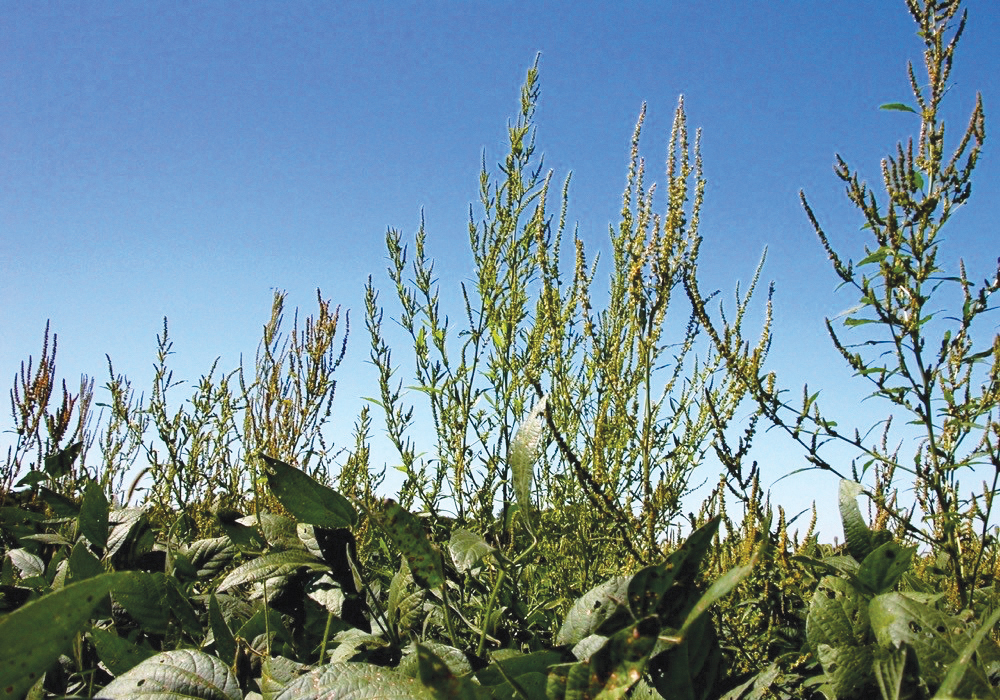Waterhemp – know your enemy
Advertisement
Hey there, time traveller!
This article was published 24/02/2024 (426 days ago), so information in it may no longer be current.
Manitoba Agriculture is urging producers to keep their eyes open for waterhemp during the upcoming crop season and do whatever it takes to keep the plant’s insidious seeds from spreading.
Tall waterhemp (Amaranthus tuberculatus), is a prolific Tier 1 weed under Manitoba’s Noxious Weed Act that can devastate crop yields. While it’s been problematic in the U.S. for years, it was only discovered in Manitoba in 2016 and confirmed in 2017. By 2019, it was found in five municipalities. That number has now risen to eight.
These detections have involved a substantial number of acres and significant hours of mowing and spraying to destroy plant material.

Tests of Manitoba waterhemp show some plants are resistant to groups 9 (glyphosate), 2 and 14 herbicides. Glyphosate resistant plants are showing up on Manitoba fields in an alarming number, producing up to a million seeds per plant.
“We’ve kept it out until now, but it is here and it’s not going away,” says Kim Brown, a provincial weed specialist who works with Manitoba Agriculture and is involved in training and extension of new and existing weed issues.
“Getting those invasive plants far away from your field and keeping them away should be a priority for every producer. You should pick them out. You should not run it through your combine because you will spread those thousands and thousands of seeds across your field. And that combine will spread it as well. You can’t clean pigweed seeds out. It’s tiny like little flakes of pepper. It just sticks. You will never clean it out. You will move it to every field once you run it through the combine.”
At a recent farm show, Brown told producers there is no clear and easy way to control waterhemp. It thrives in hot, dry weather and germinates throughout the summer. Once you have it, it’s almost impossible to get rid of it.
What should you do if you detect water hemp on your field?
Brown says weed control must be done when the weeds are small, less than 10 cm or four inches. However, “Rescue treatments” of herbicides have resulted in poor control, at best.
Brown believes proper consistent management is the key.
“You’re not going to get a population in a field that is 100 percent resistant to absolutely everything. You’re going to have combinations. And that’s why you keep using lots of different products. Some of them are only going to work on some of those plants. But you have to keep throwing stuff at it.”
Waterhemp does not appear to be a problem in competitive crops like wheat and canola, but it is a serious issue with corn, dry beans, sunflowers, and soybeans.
Brown says there are lots of things producers can do that don’t involve a lot of extra capital or work.
“You could try herbicide layering to get weeds out early when the crop is non-competitive, and in-crop options become limited.”

Other options include narrow windrow burning, chaff carts, chaff lining and tramlining, and weed seed impact mills. Optimizing combine settings to ensure weed seeds are captured has also been shown to be effective in waterhemp management.
Manitoba Agriculture also encourages direct baling, right behind the combine so nothing hits the ground, and the chaff and the straw are dropped on the conveyor belt and go into a baler.
“Those weed seeds are still there, but they’re in that bale. And they’re moved off the field. So that is something that we are very concerned about, but that at least stops them from spreading in that particular field. And if that straw is being used as feed somewhere, we have to watch that manure. Those seeds are not slowed down at all by going through an animal.”
Brown says producers need to learn to practice weed control with non-chemical methods. “The chemicals we have will fail. It’s only going to get worse. So, we have to do everything we can outside the spray tank to reduce the number of weeds we are spraying and the number of weeds on our field.”
Manitoba municipalities are watching their ditches and mowing them, so waterhemp will not seed, but even this measure has limited results.
“Everywhere where there is a gap or black dirt, the seeds can take a hold. Every seed is resistant and can grow as big as it wants. We have to do everything we can to stop the seed from returning to the soil. We can do lots of things, like pick a taller variety of crop, seed heavy, and ensure good fertility to get that crop up and going. We want to have good emergence. We need to cover the ground quickly and we won’t have these problems.”
Farmers who spot an unusual looking weed should contact their agronomist or Kim Brown at kim.brown@gov.mb.ca. They can also submit samples to the PSI Lab at mbpestlab.ca/about/.
